Shipping container delivery.
How we deliver shipping containers.
Tilt-bed truck

The tilt-bed truck can deliver containers up to 24’ long or a combination thereof (i.e: 2 x 10’ containers). This is the smallest truck in our delivery fleet and has the tightest turning radius. It is suited for inner-city deliveries, mountain roads, and limited access sites.
This truck is backed up to where you want the container placed; the bed is titled and the container is rolled off the back of the truck into position. This truck requires at least 60-feet of straight line clearance to safely complete this delivery. When placing your order, we will ask whether you want the container loaded with the doors facing the cab or the rear of the truck as this determines the final door placement at the site after delivery.
Please let us know if there are clearance concerns at the site or en route to the site. We will be happy to preview the route before delivery. Rental storage containers 24’ and smaller are delivered and picked-up using these trucks.

Tilt-bed truck and trailer

The tilt-bed truck and trailer combo can deliver containers up to 45’ in length or a combination thereof (i.e: 2 x 20’ containers, 4 x 10’ containers). This truck requires 100-feet of straight line clearance to complete the delivery. First, the truck is backed up to where you want the container placed. Next, the trailer is titled and then, the container is rolled off the back of the trailer. When booking your order delivery, we’ll ask whether the container is to be loaded with the doors facing the cab or the rear of the truck. This positioning determines the final door placement at the delivery site.
Please let us know if there are any clearance concerns at the site or en route to the site. We will be happy to preview the route before delivery to confirm the delivery can be completed. Our 40’ standard, 40’ high cube, 45’ high cube, or 2 x 20’ rental storage containers are delivered and picked-up on these trucks.
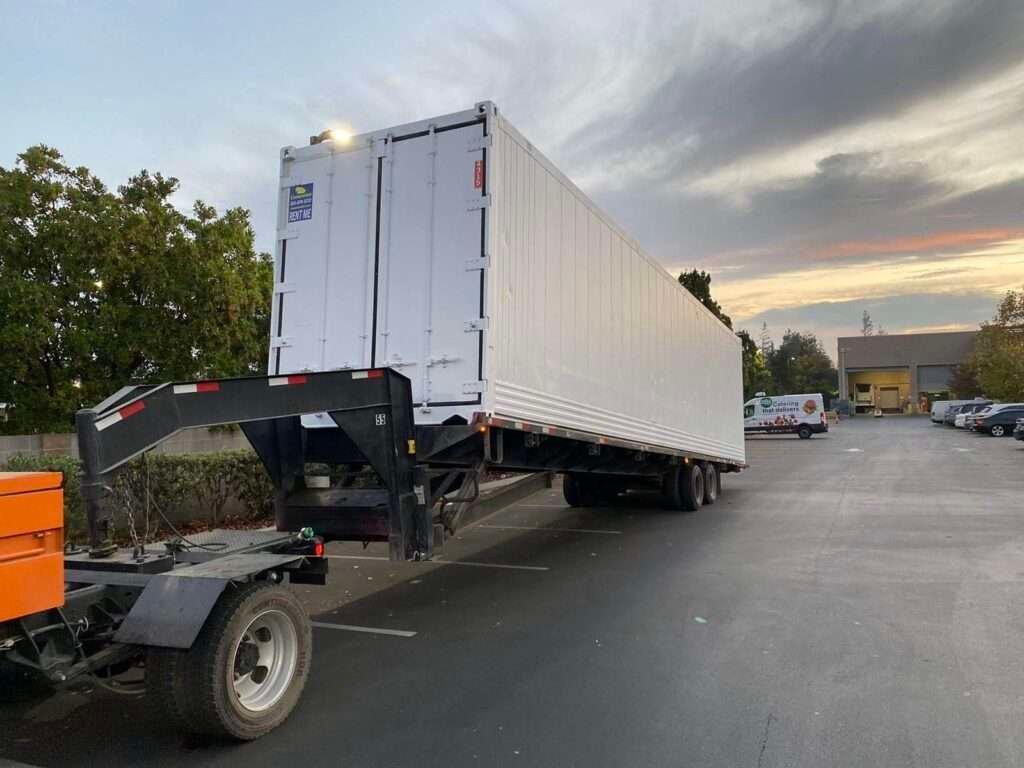
Flat-bed truck

The flat-bed truck can deliver containers up to 45’ in length. Unlike the tilt-bed truck option, we are not able to place containers on the ground. A forklift, crane, or other offloading equipment is required at the site to complete delivery. Generally, this delivery truck option is selected if your delivery location is more than 200 miles from the location of one of our yards.
Please let us know if there are any clearance concerns at the site or en route to the site. We will be happy to preview the route before delivery to confirm the delivery can be completed.
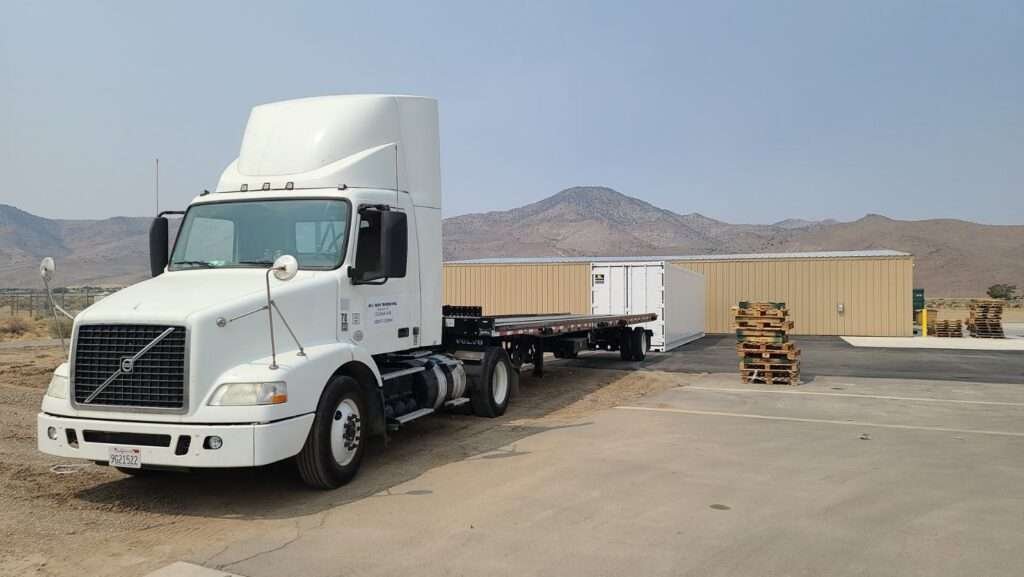
Side-lifter truck

The side-lifter truck uses 2 sliding cranes mounted towards the front and the rear of the trailer to place the container on the ground or lift the container onto the trailer. This truck delivers containers from 20’ – 45’ in length or two 20 ft containers, provided that all containers have 4 bottom ISO corner castings. The side-lifter truck is the largest truck in our delivery fleet.
The main advantage of the side-lifter truck is its load capacity of 42,000 lbs. This truck easily transfers containers from other trailers or chassis at your site, managing a load capacity of up to 72,000 lbs. Provided a solid level surface is available on-site, The side-lifter truck can stack containers up to 2 levels high. To achieve this, the driver positions the truck adjacent to where the container is to be placed. Next, the outriggers are set, and then the container is offloaded or loaded from the driver’s side only.
When booking your order delivery, we’ll ask whether the container is to be loaded with the doors facing the cab or the rear of the truck. This positioning determines the final door placement at the delivery site.
The side-lifter truck is more expensive than the tilt-bed truck delivery option because it does not require a 100-feet straight line clearance to complete the delivery. Further, a side-lifter truck is used if the container needs to be set on an elevated platform or stacked on top of another container.
Please let us know if there are any clearance concerns at the site or en route to the site. We will be happy to preview the route before delivery to confirm the delivery can be completed.
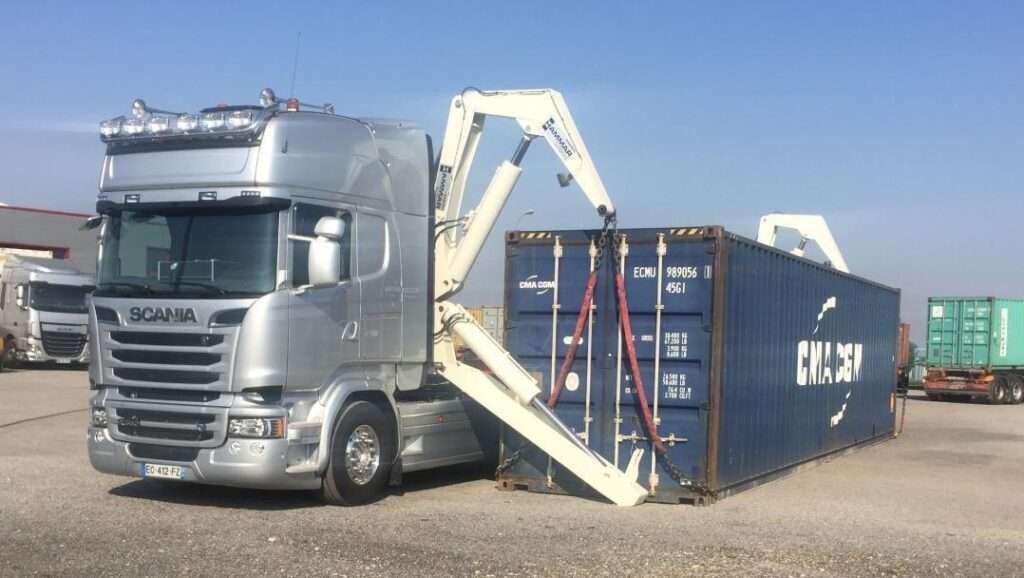
Crane truck
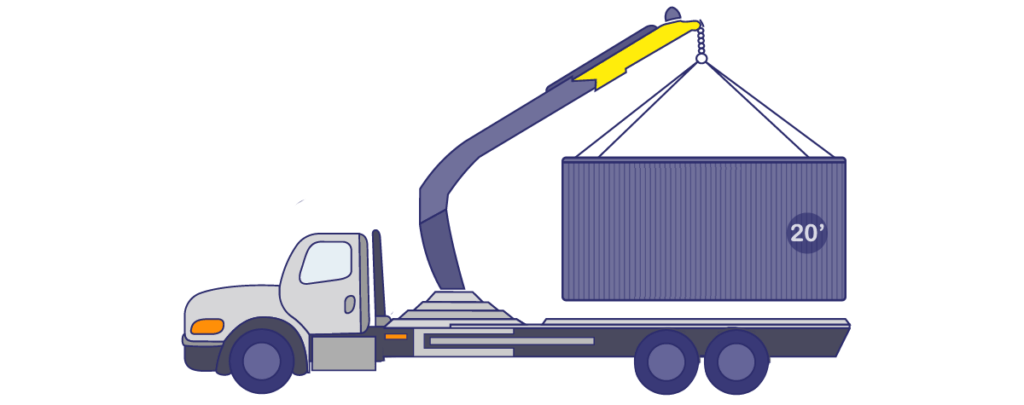
The crane truck can deliver containers up to 24’ in length or a combination thereof. This truck can also pull a trailer if multiple 20’ (or smaller) containers are to be delivered to the same location. A crane is mounted between the cab and the deck to load and offload containers. Under standard circumstances, the crane can place a 20’ container about 25’ away from the truck. This truck is operated by a certified crane operator.
The crane truck is a great delivery option if the container needs to be placed over a fence, on an elevated platform, stacked on top of another container, or if precision placement is of utmost importance. Please note, the feasibility of every delivery placement is assessed on a case by case basis.
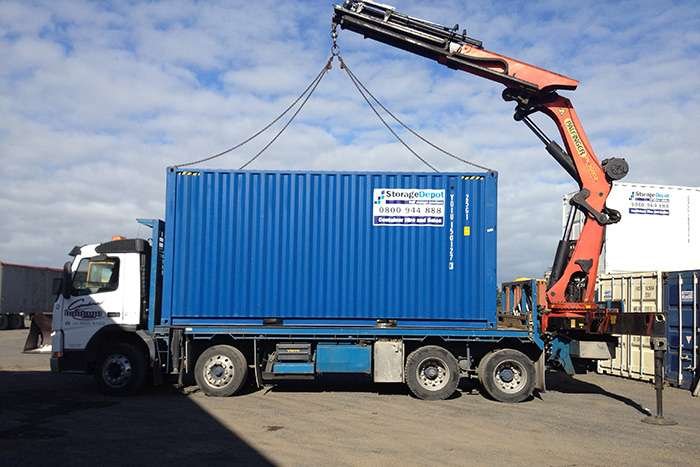
To prepare your site for delivery, your shipping container should be placed on firm, dry, level ground, i.e. pavement, gravel, or hard dirt.
The tilt-bed and flat-bed truck deliveries are quoted a flat rate that includes 30 minutes of offloading time. If the site is not ready to receive delivery, equipment is not prepared, or etc., and additional time is required, an hourly rate per our terms & conditions will be charged in 15 minute increments.
The side-lifter and crane truck deliveries are generally billed at an hourly rate, beginning when the driver leaves our yard and concluding when the driver returns to our yard.
ACCESSIBILITY & GROUND CONDITIONS
The weight of the trailer and empty container are also a consideration for a successful delivery. As the combined weight can exceed 50,000lbs, we recommend delivering on firm ground that is able to support the weight and prevent the trailer from sinking. This is especially a factor on grass or a desired location that requires the truck to cross an unpaved field or similar terrain.
On arrival, the delivery drivers will assess delivery conditions on site (accessibility and ground conditions) and determine if they can proceed with the delivery as planned. If the requirements are not met, they can refuse delivery which will result in delivery charges applying for the unsuccessful trip or they may propose to drop in an alternate location that is more easily accessible.
If you have any questions about any of the above-mentioned delivery considerations, please don’t hesitate to contact us and we will be happy to guide you through the process to better assess your site.
LEVEL GROUND
One of the most important factors we can recommend is to ensure that the containers doors are sitting on a relatively level ground surface on delivery. This prevents the frame from bending and twisting which can lead to eventual issues opening and closing the doors over time. For this reason, we recommend any of the following surfaces for your storage container: concrete pad, pavement, crushed gravel base, railroad ties, concrete blocks, wood, etc.
We also strongly recommend that the container does not sit directly in grass or surfaces where water can pool to extend the longevity of your sea container. Excess moisture can rot the undercarriage of the container which can affect the structural integrity of the flooring.
OBSTRUCTIONS
Obstructions can cause delays or completely halt the delivery process. Obstructions that can prevent a delivery include but are not limited to: low hanging tree branches, powerlines, heavy traffic, , parked cars, etc. Ensuring the desired location is free of any of these elements will avoid unnecessary delays which can results in additional delivery charges.
DOOR LOADING DIRECTION
Most standard shipping containers have doors on one end. So the placement of the original container doors on the truck is very important to consider for its final placement at your location.
Keeping in mind that the truck backs into position to tilt the container onto the ground, loading the truck with the container doors facing the rear will result in the doors being placed in their final position first.
If the container doors are loaded to face the cab of the truck, the doors will be the last part of the container to be placed onto the ground. While the sales team can certainly help explain the process in more detail, it is the customer who better understands the final placement on site and must provide us appropriate door loading directions for delivery.
DOORS TO CAB

DOORS TO REAR

END OF LEASE PICK UP PROCEDURES
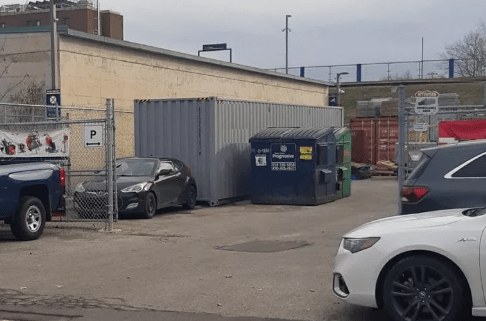
For rental customers, we ask that you kindly advise us by email 2-3 business days prior to the end of the lease of a container rental in order to ensure adequate time to arrange pick up of the container. The specialized trailers that carry containers are often booked many days in advance so it is difficult to guarantee same or next day pick up at the end of the rental period. This is especially important to keep in mind if the timing of pick up is critical for the next steps on site. Once pick up has been scheduled, please ensure the container is completely empty and accessible for pick up. Additional charges may apply for on-site waiting time if the container is blocked on-site or if debris is left inside. Please note that the container must be returned to us in the same condition while allowing for normal wear and tear.
- Advise 2-3 days prior to pick up
- Ensure the container is empty and accessible
COLD WEATHER ISSUES
For commercial and industrial container rental customers, our Canadian winters can have an impact at the end of the lease term when it is time to arrange pick up of the container. When calling to request a container pick up in the winter months, there are a few issues to take note of to avoid additional delivery costs. As a starting point, the container must be free and clear of snow on the roof. This is a ministry of transportation directive and the driver can refuse to pick up if this criteria is not met as they can risk significant fines on the road for falling snow and ice while driving. Oftentimes, the container can also be frozen in the ground and the tilt bed is unable to lift the corners. To prevent this issue, we often recommend heavily salting the four corner castings where the container makes contact with the ground, the day PRIOR to pick up.
- Remove all snow & ice from the roof
- Apply salt to four corners on day prior to pick up
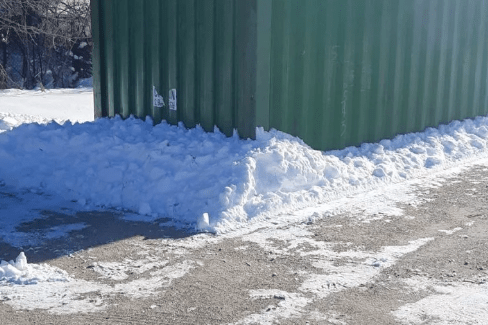
For all deliveries, our dispatcher will call the site contact 24 hours in advance to confirm the 2-hour delivery window. The day of delivery, the truck driver will be call the site contact with a 30-minute delivery window.
Terms & conditions apply to all deliveries.
